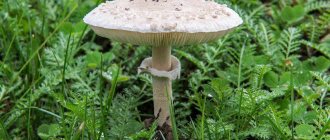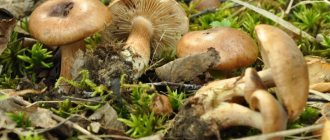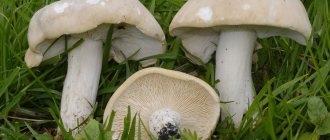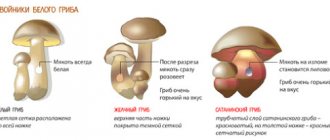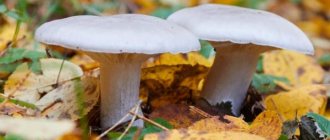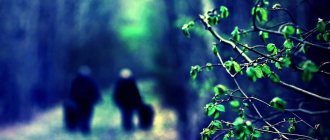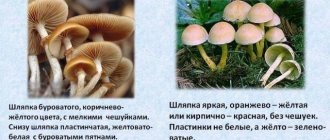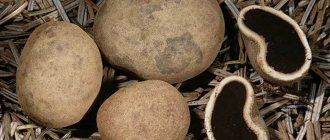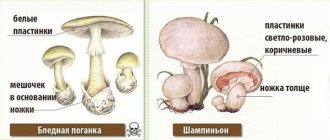Mushrooms are beautiful, unique representatives of the kingdom of living nature, differing from each other in color, cap shape and even taste. Their appearance can be simple and ornate, original and caricatured. Probably every mushroom picker has admired the elegance and grace of these protein delicacies at least once in their life.
Have you ever come across an orange mushroom? If so, then you probably noticed its bright, cheerful color and thought - is it edible? This article will be devoted to this organism. What is an orange mushroom? Where does it grow? Can it be eaten? Moreover, a little lower we will examine another, no less important question: “How to distinguish edible mushrooms from inedible ones, so as not to get confused and not make a fatal mistake?”
Boletus and its description
The most common orange mushroom is boletus. This family is considered completely edible and includes many subspecies. First of all, these are red, yellow-brown and oak boletus. It is their caps that have a bright, rich orange color.
Red boletus (also called redhead, or red boletus) has very tasty fleshy white pulp. A hat of this type can reach thirty centimeters in diameter, but often the sizes vary from four to fifteen centimeters. The color of the cap of this large orange mushroom is most often dominated by reddish or reddish shades. It is worth mentioning here that the color depends on the growing conditions. For example, in forests where aspen trees predominate, the mushroom cap has dark red hues. If poplars are more common, then the cap becomes slightly grayish, but if the forests are mixed, then it becomes orange or yellow-red.
The gray scaly legs of the mushroom, expanding towards the bottom, also have different lengths (from five to fifteen centimeters) and thickness (from one and a half to five centimeters). The red boletus is not capricious in relation to trees with which it enters into a natural symbiosis. They can be oaks, birches, beeches, hornbeams and, of course, aspens and poplars. The growing season of the mushroom is from June to October. Most often it can be found under young trees, in damp aspen groves and even along roads. Redhead is tasty in any preparation. However, many recommend removing its legs, as they are quite harsh in taste and difficult to digest in the human gastrointestinal tract.
Yellow-brown boletus is another variety of orange mushroom. Its hemispherical cap with a diameter of five to fifteen centimeters can sometimes reach 25 cm. It has dry, rough skin of orange or yellow-brown color. The white, dense flesh of the mushroom begins to turn blue when cut. The leg of the yellow-brown boletus can be very thick (2-4 cm in diameter, sometimes reaching seven centimeters). Its length is also varied and depends on the parameters of the entire specimen: from eight to fifteen centimeters and above. The yellow-brown boletus prefers to create mycorrhiza with birch. It loves to grow in mixed forests and pine forests. Ripening season: from June to September, sometimes until November.
Redhead oak (or oakhead) is an orange-colored mushroom that grows in the north of our country. It forms symbiotic associations with oak trees, beginning to appear from mid-summer until late autumn. The hemispherical cap of the oak plant can vary between eight and fifteen centimeters in diameter. Usually its skin is chestnut in color with an orange tint. The pulp is white, has brown-gray veins, and may turn black when cut. The cylindrical stem of the mushroom, 10-15 cm high and 2-3 cm thick, has small scales and can thicken at the base.
Encyclopedia of mushrooms. Mushrooms
Mushrooms
(Fungi or Mycetes)
a separate group (division) of lower plants lacking chlorophyll. For their development, G. need ready-made organic substances, that is, they are heterotrophic organisms (See Heterotrophic organisms). They usually settle on plants, animals or their remains. Depending on the nutrient substrate (living or dead), G. are divided into parasites (see Parasitism) and saprophytes (See Saprophytes), including edible and poisonous G. for humans and animals. There are over 100 thousand species of G. The science of G. called mycology (See mycology).
The structure of G. In most G., with the exception of some forms of intracellular parasites (Fig. 1), the vegetative body is in the form of mycelium (mycelium), i.e. consists of thin branching threads, or hyphae, growing at their ends and spreading on the surface or inside the nutrient substrate. The developing mycelium often has the appearance of a delicate, fluffy or cobwebby coating, thin films or cotton wool-like accumulations; may vary depending on development conditions. For example, in cracks in wood infected with polypore fungi, rather thick and dense mycelial films develop. Among the modifications of the mycelium, there are: mycelial strands (cord-like formations consisting of hyphae located in parallel and often fused in the longitudinal direction, for example in a true house mushroom), rhizomorphs and sclerotia (See Sclerotium) (Fig. 2).
Reproduction of G. In G., a distinction is made between vegetative and reproductive (both asexual and sexual) reproduction. The stage of sexual reproduction of G. is called perfect, or highest, and the stage of asexual reproductive reproduction is called imperfect. Vegetative propagation is carried out by scraps or particles of mycelium, cords and rhizomorphs, as well as sclerotia. These particles disperse in various ways and, once in a favorable environment, can give rise to the development of a new mycelium. A more specialized method of this type of reproduction is the separation of the mycelium into individual cells (Spores) - oidia, gemma and chlamydospores. Oidia are round or elongated cells, covered with a thin membrane, unable to survive for a long time (found mostly in gymnasiums and many other organisms); gemmas have a thicker, usually colored shell and are capable of long-term preservation (they are found in marsupials, lower animals, imperfect gems, as well as in some smuts, in particular in the causative agents of oat smut); Chlamydospores arise through the isolation and compaction of individual sections of the hyphae, which are then covered with a thick, dark-colored membrane (they are characteristic of many smuts and are found in marsupials and fusariids). A type of vegetative propagation is budding, which is characteristic of yeast.
Such common saffron milk caps
Camelina is another variety of orange mushroom. They are distinguished by their bright orange, even red color. They are highly valued for their taste; some subspecies are even considered a delicacy. Saffron milk caps owe their color to a substance such as beta-carotene, which is converted into beneficial microelements (B vitamins, ascorbic acid, vitamin A).
This family is also rich in mineral salts of iron, magnesium, phosphorus, sodium and even calcium. Moreover, these mushrooms contain a natural antibiotic - lactrioviolin, which is used for inflammatory diseases and is used in complex therapy in the treatment of tuberculosis. Let's talk about some types of these edible orange mushrooms.
Interesting Facts
Cobweb apricot-yellow.
Since most of the spider webs are inedible, and some are even poisonous, and they do not differ much from each other, you should know how to act in case of spider web poisoning:
- Firstly, if you notice symptoms of poisoning (abdominal pain, nausea, vomiting, dry mouth), you should immediately call an ambulance.
- Secondly, the poisoned person needs to have his stomach rinsed and given an enema, then put to bed and given saline solutions to replenish electrolytes until the ambulance arrives.
The saffron milk cap is real
Sometimes it is also called the delicious milkweed. It belongs to the lamellar mushrooms, completely orange in color. The smooth and shiny cap of this species can reach from 4 to 18 centimeters in diameter. Its surface, which has brown spots, is sticky and unpleasant to the touch in wet weather. Frequent and thin plates, orange, like the whole mushroom, can turn slightly green when pressed.
The leg of the true camelina is low (up to seven centimeters) and thin (two centimeters in diameter), and can be covered with soft light fluff. The dense flesh also has an orange color that turns green when broken. The delicious milkweed is often found in pine or spruce forests, where it hides in thick grass or among moss. Growing season: July to October.
Spruce mushroom
This is a mushroom with an orange cap from the Russula family. Its cylindrical leg (three to seven centimeters high and one centimeter thick) is quite brittle and hollow inside. The orange pulp, turning green when broken, has a fruity aroma and taste. The small orange cap of the plant has a diameter of four to eight centimeters. The plates, descending and frequent, are slightly lighter than the cap itself. The color of the mushroom itself can vary between pale pink and dark orange. Spruce saffron milk caps grow from summer to autumn in spruce forests, hiding in the natural litter covered with pine needles.
Red saffron milk caps
This is another variety of lamellar mushrooms. The cap is orange in color, dense and fleshy to the touch, and varies in diameter from five to fifteen centimeters. The flesh of the mushroom is white, with dark red spots randomly located on it. When broken, the pulp releases thick, blood-red juice. Frequent and thin plates, located under the bottom of the cap, descend deeply along the stem of the camelina. The leg itself is small, about four to six centimeters high, tapering towards the bottom. It is covered with plaque and furrowed with red pits. The color of the leg can be different: orange, pink and even purple. This type of mushroom is not widespread in Russia; it most often grows in coniferous forests on mountainous slopes.
Small varieties
Bear's ears (or Sarcoscypha scarlet) are small orange mushrooms found throughout the world, but rarely used in traditional cooking. The pulp of these mushrooms is very elastic, but edible, especially tasty after frying in a heated frying pan. The caps of this species, up to five centimeters in diameter, usually have an orange-scarlet color. Mushrooms grow on felled tree trunks covered with a layer of soil or dry leaves. They appear in the cool season (early spring or even winter).
Another type of small mushroom is orange aleuria, distinguished by its unusual appearance. The fruiting body of the mushroom is saucer-shaped, varied in shape and size. These representatives of eukaryotes usually do not exceed five centimeters in height. This small, bright orange mushroom has thin, cartilaginous pulp, pleasant to the taste and aroma, as well as a short, slightly pronounced stem. Orange aleuria grows in a variety of forest plantations and can even be found in parks, on lawns and between stones. Grows in soil from summer to late autumn. This mushroom can be used in cooking after drying, for example, adding it to soups or stir-fries.
Preparation
Processing oyster mushrooms in this case will not take much of your time. Before you start heat treatment, you need to learn a few simple but important rules:
- These mushrooms must be cut before cooking, and not after it.
- If you fry or bake oyster mushrooms, then you should not cook them before;
- Before starting preparation, the fruiting bodies must be thoroughly washed under running water;
- There is no need to soak oyster mushrooms.
Cleaning mushrooms
To carry out this operation you will need:
- Place mushrooms in a colander.
- Rinse thoroughly under cold water. It’s better to place some oyster mushrooms in a colander to help them clean better.
- Using a knife, cut off those places that have rotted or dried out.
- Wash well again under running water.
Frying
You will need to do the following:
- Cut the mushrooms into small pieces and place in a hot frying pan with vegetable oil.
- Fry until golden brown.
- Add salt and pepper to taste.
Extinguishing
Ingredients:
- 1 kg of mushrooms;
- 2 pcs. Luke;
- 20 grams of chopped herbs (dill and parsley);
- 5 g salt;
- 5 g pepper;
- 350 ml sour cream.
Preparation:
- Chop the mushrooms into small pieces.
- Dice the onion and fry it for 7 minutes until golden brown.
- Add the chopped oyster mushrooms and fry until the liquid leaves the mushrooms.
- Add herbs, salt, pepper and sour cream.
- Simmer for 15 minutes.
Pickling
Ingredients:
- 1 kg of mushrooms;
- 2 onions;
- 200 g water;
- 50 g sugar;
- 10 g salt;
- 30 ml vinegar;
- 3 cloves of garlic.
Preparation:
- Cut the washed and peeled mushrooms into small slices and place in a container with salted water.
- Boil for about 10 minutes.
- Place the oyster mushrooms in a colander.
- Cut the onions into half rings.
- Separately, in a small saucepan, combine water, garlic, sugar, salt and vinegar.
- Place a layer of mushrooms in a deep container, place onions on top, then repeat the sequence.
- Pour over the marinade and place under pressure.
- Preparing pickled oyster mushrooms will take 8 hours. Workpieces must be stored in a cool place.
Unusual species
Among the natural diversity of orange mushrooms, specimens of non-standard shape are also distinguished. First of all, these are the orange hornet and the sulfur-yellow tinder fungus. Rogatik has a thin, club-shaped body, slightly oblong and pleasant to the taste. Grows from late summer until cold weather, loves dry open places and clearings. The tinder fungus, on the contrary, appears in May and bears fruit until September. This representative of wildlife is conditionally edible, as it can cause some toxic reactions. The fungus is a parasite that affects trees such as poplar, pine, oak, willow, birch, chestnut, and walnut.
Its fruiting body is heterogeneous, up to seven centimeters thick and the cap size from ten to forty centimeters. It can weigh up to nine kilograms. The pulp of the mushroom is soft and juicy, sour in taste, with an unusual lemon smell. However, if the polypore grows old, its nutritional and aromatic qualities quickly deteriorate. Young mushrooms are used boiled and fried, for pickling and as a filling for pies. After drying, they become brittle, fibrous and very light, and can be stored frozen for a long time. If the mushroom is old or grows on conifers, then it should not be eaten, as it can cause all kinds of allergic reactions and poisoning.
Chanterelles
Chanterelles are a whole family of mushrooms with an orange stem and the same cap. Not all of them are edible, as it might seem at first glance. The following names of mushrooms are considered tasty and nutritious: velvety chanterelle, faceted chanterelle and yellow hedgehog.
The cap of the velvety fox is small, about four to five centimeters. The leg is also small, measuring two to three centimeters. The orange pulp is tender and slightly sour in taste. The fungus settles in acidic soil, mainly among deciduous plants.
The faceted chanterelle is a very beautiful representative of wildlife, with a fibrous fruiting body ranging in size from three to ten centimeters. Forms mycorrhiza with oak and grows from June to October. Poisonous chanterelles include species such as the false chanterelle and olive omphalot, which is found quite rarely, mainly in the Crimea.
Application
Cooking
Edible spider web mushrooms are considered a delicacy; they have a wonderful nutty taste. Tolstushka is delicious fried or stewed with sour cream or cream. Decoctions from the plum are used to make broth. The edible fruiting bodies are also pickled and dried, but this can result in the loss of much of the flavor.
The excellent cobweb is dried or pickled only after long soaking and boiling. Young specimens are suitable for pickling and salting. For your information. The shiny coating on the cap of the purple cobweb species disappears when dried.
Poisonous
False chanterelle is an inedible orange mushroom that resembles a chanterelle. Its other name is orange talker. The talker differs from its edible counterparts in the red-orange hue of the cap and almost smooth edges, as well as an unpleasant odor. The mushroom cap varies between two and six centimeters in diameter, and the stalk, usually very short, rarely reaches four centimeters. And yet, false chanterelle is considered a conditionally inedible product, as it is successfully used in the cooking of other countries after long and thorough heat treatment.
Orange-red cobweb is another type of poisonous mushroom that is considered deadly. The hemispherical cap of the spider web has a small tubercle in the very center, and the leg, small in height, tapers towards the base.
So, we briefly looked at the description of different mushrooms with orange colors. Now let's briefly discuss how to distinguish an edible mushroom from an inedible one.
Toxic substances
The most beautiful cobweb is a rare, deadly poisonous mushroom that contains a very strong toxin, a complex polypeptide - orellan. It does not lose its toxic properties after being treated at high temperatures, placed in a different acidic environment and dried. Toxicity is greatly reduced only under the influence of ultraviolet and solar radiation. This mushroom contains 7.5 mg of orellanine for every 1 g of dried mushrooms.
Experts believe that in addition to orellanine, mushrooms contain two additional polypeptides – cortinarine A and B, which determine the totality of manifestations in the form of patient complaints. The combined presence of these 3 components was revealed only in 2 species of mushrooms of this family: the beautiful cobweb (reddish) and the orange-red.
Note to mushroom pickers
- First of all, mushrooms that cannot be eaten are distinguished by the fact that when cut, their flesh turns an unnatural color and emits an unpleasant odor (fetid or medicinal). Sometimes the caps of these varieties have a sticky coating.
- Also take a closer look at the appearance of the mushroom: if it has no insects or worms inside or outside, then it is most likely a poisonous mushroom. Moreover, the inedibility of many species is indicated by the absence of a tubular layer located under the cap.
- And the most important rule: do not taste the mushrooms! If in doubt, don't cut it. Go mushroom hunting only with knowledgeable people. Don't pack everything in hopes of sorting it out at home.
If all the above recommendations are followed, then you will definitely please yourself and your loved ones with delicious and aromatic orange mushrooms.
Conclusion
Based on all of the above, we can conclude that tremors are an incredibly tasty and at the same time healthy mushroom. It will help fight colds and relieve a number of diseases. And also, it naturally helps restore the immune system, which is important in our time.
Orange tremors will decorate your table and will be organically combined with any products in any dishes.
Collect this mushroom in order to experiment and finally try what it is. In fact, the orange trembler is widespread throughout Russia; finding it is not difficult.
Look carefully at the branches of the trees, and then, soon, you will find a bright yellow spot, which will open for you the wonderful world of the taste of tremors.
